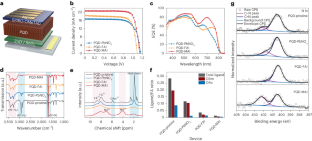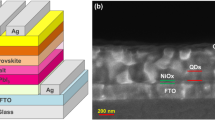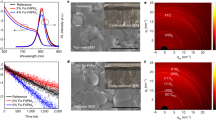Abstract
Whereas lead halide perovskite-based colloidal quantum dots (PQDs) have emerged as a promising photoactive material for solar cells, the research to this point has predominantly focused on inorganic cation PQDs despite the fact that organic cation PQDs have more favourable bandgaps. In this work, we develop solar cells using narrow bandgap organic cation-based PQDs and demonstrate substantially higher efficiency compared with their inorganic counterparts. We employ an alkyl ammonium iodide-based ligand exchange strategy, which proves to be substantially more efficient in replacing the long-chain oleyl ligands than conventional methyl acetate-based ligand exchange while stabilizing the α phase of organic PQDs in ambient conditions. We show a solar cell with the organic cation PQDs with high certified quasi-steady-state efficiency of 18.1% with 1,200-h stability under illumination at open-circuit conditions and 300-h stability at 80 °C.
This is a preview of subscription content, access via your institution
Access options
Access Nature and 54 other Nature Portfolio journals
Get Nature+, our best-value online-access subscription
$29.99 / 30 days
cancel any time
Subscribe to this journal
Receive 12 digital issues and online access to articles
$119.00 per year
only $9.92 per issue
Buy this article
- Purchase on Springer Link
- Instant access to full article PDF
Prices may be subject to local taxes which are calculated during checkout




Similar content being viewed by others
Data availability
The data supporting the findings of this study are included within the article and its Supplementary Information files.
References
Swarnkar, A. et al. Quantum dot-induced phase stabilization of α-CsPbI3 perovskite for high-efficiency photovoltaics. Science 354, 92–95 (2016).
Hao, M. et al. Ligand-assisted cation-exchange engineering for high-efficiency colloidal Cs1−xFAxPbI3 quantum dot solar cells with reduced phase segregation. Nat. Energy 5, 79–88 (2020).
Hassan, Y. et al. Ligand-engineered bandgap stability in mixed-halide perovskite LEDs. Nature 591, 72–77 (2021).
Xue, J. et al. Surface ligand management for stable FAPbI3 perovskite quantum dot solar cells. Joule 2, 1866–1878 (2018).
Cui, Y. et al. An explanation for high defect tolerance in metal halide perovskite quantum dots. Phys. Status Solidi RRL 15, 2100016 (2021).
Sanehira, E. M. et al. Enhanced mobility CsPbI3 quantum dot arrays for record-efficiency, high-voltage photovoltaic cells. Sci. Adv. 3, eaao4204 (2017).
Yuan, J. Y. et al. Band-aligned polymeric hole transport materials for extremely low energy loss alpha-CsPbI3 perovskite nanocrystal solar cells. Joule 2, 2450–2463 (2018).
Vidal, R. et al. Assessing health and environmental impacts of solvents for producing perovskite solar cells. Nat. Sustain. 4, 277–285 (2021).
Zhao, Q. et al. High efficiency perovskite quantum dot solar cells with charge separating heterostructure. Nat. Commun. 10, 2842 (2019).
Ling, X. et al. Guanidinium-assisted surface matrix engineering for highly efficient perovskite quantum dot photovoltaics. Adv. Mater. 32, 2001906 (2020).
Li, Z. et al. Stabilizing perovskite structures by tuning tolerance factor: formation of formamidinium and cesium lead iodide solid-state alloys. Chem. Mater. 28, 284–292 (2016).
Jia, D. et al. Surface matrix curing of inorganic CsPbI3 perovskite quantum dots for solar cells with efficiency over 16%. Energy Environ. Sci. 14, 4599–4609 (2021).
Jia, D. L. et al. Inhibiting lattice distortion of CsPbI3 perovskite quantum dots for solar cells with efficiency over 16.6%. Energy Environ. Sci. 15, 4201–4212 (2022).
Prasanna, R. et al. Band gap tuning via lattice contraction and octahedral tilting in perovskite materials for photovoltaics. J. Am. Chem. Soc. 139, 11117–11124 (2017).
Lee, J.-W., Seol, D.-J., Cho, A.-N. & Park, N.-G. High-efficiency perovskite solar cells based on the black polymorph of HC(NH2)2PbI3. Adv. Mater. 26, 4991–4998 (2014).
Xue, J. et al. A small-molecule ‘charge driver’ enables perovskite quantum dot solar cells with efficiency approaching 13%. Adv. Mater. 31, 1900111 (2019).
Ji, K. et al. High-efficiency perovskite quantum dot solar cells benefiting from a conjugated polymer-quantum dot bulk heterojunction connecting layer. J. Mater. Chem. A 8, 8104–8112 (2020).
Ding, S. et al. In situ bonding regulation of surface ligands for efficient and stable FAPbI3 quantum dot solar cells. Adv. Sci. 9, e2204476 (2022).
Zhang, X. et al. Ligand-assisted coupling manipulation for efficient and stable FAPbI3 colloidal quantum dot solar cells. Angew. Chem. Int. Ed. 62, e202214241 (2023).
Li, M. J. et al. Low threshold and efficient multiple exciton generation in halide perovskite nanocrystals. Nat. Commun. 9, 4197 (2018).
Kulbak, M. et al. Cesium enhances long-term stability of lead bromide perovskite-based solar cells. J. Phys. Chem. Lett. 7, 167–172 (2016).
Lee, J.-W. et al. Formamidinium and cesium hybridization for photo- and moisture-stable perovskite solar cell. Adv. Energy Mater. 5, 1501310 (2015).
Protesescu, L. et al. Dismantling the ‘red wall’ of colloidal perovskites: highly luminescent formamidinium and formamidinium–cesium lead iodide nanocrystals. ACS Nano 11, 3119–3134 (2017).
Galkowski, K. et al. Determination of the exciton binding energy and effective masses for methylammonium and formamidinium lead tri-halide perovskite semiconductors. Energy Environ. Sci. 9, 962–970 (2016).
Jeong, J. et al. Pseudo-halide anion engineering for α-FAPbI3 perovskite solar cells. Nature 592, 381–385 (2021).
Wheeler, L. M. et al. Targeted ligand-exchange chemistry on cesium lead halide perovskite quantum dots for high-efficiency photovoltaics. J. Am. Chem. Soc. 140, 10504–10513 (2018).
Zheng, X. et al. Managing grains and interfaces via ligand anchoring enables 22.3%-efficiency inverted perovskite solar cells. Nat. Energy 5, 131–140 (2020).
De Roo, J. et al. Highly dynamic ligand binding and light absorption coefficient of cesium lead bromide perovskite nanocrystals. ACS Nano 10, 2071–2081 (2016).
Xu, Y. Z. et al. Ion-assisted ligand exchange for efficient and stable inverted FAPbI3 quantum dot solar cells. ACS Appl. Energy Mater. 5, 9858–9869 (2022).
Kim, Y. et al. Efficient luminescence from perovskite quantum dot solids. ACS Appl. Mater. Interfaces 7, 25007–25013 (2015).
Jia, D. et al. Antisolvent-assisted in-situ cation exchange of perovskite quantum dots for efficient solar cells. Adv. Mater. 35, 2212160 (2023).
Chen, J., Seo, J.-Y. & Park, N.-G. Simultaneous improvement of photovoltaic performance and stability by in situ formation of 2D perovskite at (FAPbI3)0.88(CsPbBr3)0.12/CuSCN interface. Adv. Energy Mater. 8, 1702714 (2018).
Kim, M. et al. Methylammonium chloride induces intermediate phase stabilization for efficient perovskite solar cells. Joule 3, 2179–2192 (2019).
Du, T. et al. Elucidating the origins of subgap tail states and open-circuit voltage in methylammonium lead triiodide perovskite solar cells. Adv. Funct. Mater. 28, 1801808 (2018).
Ip, A. H. et al. Hybrid passivated colloidal quantum dot solids. Nat. Nanotechnol. 7, 577–582 (2012).
Shi, D. et al. Low trap-state density and long carrier diffusion in organolead trihalide perovskite single crystals. Science 347, 519–522 (2015).
Dong, Q. F. et al. Electron-hole diffusion lengths >175 μm in solution-grown CH3NH3PbI3 single crystals. Science 347, 967–970 (2015).
Fan, Y. P., Meng, H. G., Wang, L. & Pang, S. P. Review of stability enhancement for formamidinium-based perovskites. Sol. RRL 3, 1900215 (2019).
Kim, S. et al. Thermodynamics of multicomponent perovskites: a guide to highly efficient and stable solar cell materials. Chem. Mater. 32, 4265–4272 (2020).
Frost, J. M. et al. Atomistic origins of high-performance in hybrid halide perovskite solar cells. Nano Lett. 14, 2584–2590 (2014).
Pellet, N. et al. Mixed-organic-cation perovskite photovoltaics for enhanced solar-light harvesting. Angew. Chem. Int. Ed. 53, 3151–3157 (2014).
Eperon, G. E., Beck, C. E. & Snaith, H. J. Cation exchange for thin film lead iodide perovskite interconversion. Mater. Horiz. 3, 63–71 (2016).
Unger, E. L. et al. Hysteresis and transient behavior in current–voltage measurements of hybrid-perovskite absorber solar cells. Energy Environ. Sci. 7, 3690–3698 (2014).
Best Research-Cell Efficiencies Chart (NREL, 2022); https://www.nrel.gov/pv/cell-efficiency.html
Azmi, R. et al. Shallow and deep trap state passivation for low-temperature processed perovskite solar cells. ACS Energy Lett. 5, 1396–1403 (2020).
Kyaw, A. K. K. et al. Improved light harvesting and improved efficiency by insertion of an optical spacer (ZnO) in solution-processed small-molecule solar cells. Nano Lett. 13, 3796–3801 (2013).
Macpherson, S. et al. Local nanoscale phase impurities are degradation sites in halide perovskites. Nature 607, 294–300 (2022).
Beek, W. J. E. et al. Hybrid zinc oxide conjugated polymer bulk heterojunction solar cells. J. Phys. Chem. B 109, 9505–9516 (2005).
Acknowledgements
We gratefully acknowledge support from the Ministry of Education of the Republic of Korea and the National Research Foundation of Korea under grant numbers NRF-2023R1A2C3002881 (Sang-Hak Lee, J.-H.H., Su-Ho Lee and S.-Y.J.), 2022M3H4A1A03076652 (Sang-Hak Lee, J.-H.H., Su-Ho Lee and S.-Y.J.) and RS-2023-00222006 (Sang-Hak Lee and S.-Y.J.).
Author information
Authors and Affiliations
Contributions
H.A. and S.-Y.J. conceived of the work. H.A., Sang-Hak Lee and I.F.I. fabricated and characterized solar cells under the guidance of S.-Y.J. H.A. and Sang-Hak Lee conducted FTIR, 1H-MAS NMR and analysis of data. I.F.I. performed TCSPC, TPV/TPC and SCLC measurements. I.F.I. and J.-H.H. conducted GIWAXS and XRD measurements. Sang-Hak Lee and Su-Ho Lee performed transmission electron microscopy, AFM and SEM measurements. S.-Y.J. directed and supervised the project. The manuscript was written by S.-Y.J. and H.A. with comments and inputs from all authors.
Corresponding author
Ethics declarations
Competing interests
The authors declare no competing interests.
Peer review
Peer review information
Nature Energy thanks Lianzhou Wang and the other, anonymous, reviewer(s) for their contribution to the peer review of this work.
Additional information
Publisher’s note Springer Nature remains neutral with regard to jurisdictional claims in published maps and institutional affiliations.
Supplementary information
Supplementary Information
Supplementary Notes 1 and 2, Figs. 1–20, Tables 1–3 and References.
Rights and permissions
Springer Nature or its licensor (e.g. a society or other partner) holds exclusive rights to this article under a publishing agreement with the author(s) or other rightsholder(s); author self-archiving of the accepted manuscript version of this article is solely governed by the terms of such publishing agreement and applicable law.
About this article
Cite this article
Aqoma, H., Lee, SH., Imran, I.F. et al. Alkyl ammonium iodide-based ligand exchange strategy for high-efficiency organic-cation perovskite quantum dot solar cells. Nat Energy 9, 324–332 (2024). https://doi.org/10.1038/s41560-024-01450-9
Received:
Accepted:
Published:
Issue Date:
DOI: https://doi.org/10.1038/s41560-024-01450-9



